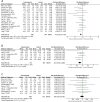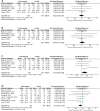Prognostic effectiveness of interactive vs. non-interactive mobile app interventions in type 2 diabetes: a systematic review and meta-analysis
- PMID: 39578910
- PMCID: PMC11583391
- DOI: 10.1186/s13690-024-01450-x
Prognostic effectiveness of interactive vs. non-interactive mobile app interventions in type 2 diabetes: a systematic review and meta-analysis
Abstract
Background: Mobile app interventions are emerging as significant tools in managing the prognosis of type 2 diabetes, demonstrating progressively greater impacts. The effectiveness of these interventions needs further evidence-based support.
Objective: This study conducted a systematic review and meta-analysis of randomized controlled trials to evaluate the effectiveness of mobile app interventions in improving prognosis for patients with type 2 diabetes.
Methods: We searched PubMed, Cochrane, Embase, and Web of Science for relevant studies published from inception to 18 April 2024, adhering to the Cochrane Handbook guidelines. The quality of the included studies was assessed using the Cochrane risk of bias tool. Primary outcomes measured were changes in glycated hemoglobin (HbA1c) and diabetes self-management (DSM). Secondary outcomes included changes in diastolic blood pressure (DBP), systolic blood pressure (SBP), triglycerides(TG), total cholesterol(TC), high-density lipoprotein (HDL), low-density lipoprotein (LDL), lipid profiles, fasting plasma glucose (FPG), body mass index (BMI), and Steps outcomes. Subgroup analyses were performed for the primary outcomes and for high-density lipoprotein (HDL), low-density lipoprotein (LDL), diastolic blood pressure (DBP), and systolic blood pressure (SBP). Interventions with or without interactions were also used as a basis for subgrouping.
Results: A total of 15 eligible articles involving 17 studies with 2,028 subjects (1,123 in the intervention group and 1,020 in the control group) were included in the synthesis. Interactive mobile app interventions significantly reduced HbA1c levels (SMD - 0.24; 95% CI, -0.33 to -0.15; P < 0.00001) and significantly improved diabetes self-care (SMD 0.71; 95% CI, 0.21 to 1.21; P = 0.005). Secondary outcomes, including FPG, LDL, DBP, and SBP, showed varying degrees of improvement. Subgroup analyses indicated that the intervention effect was more pronounced and less heterogeneous in the short-term (≤ 3 months) for younger Asian individuals (< 55 years) who used an interactive mobile app.
Conclusion: Interactive mobile app interventions effectively improve HbA1c levels and diabetes self-care competencies in patients with type 2 diabetes. These interventions offer supportive evidence for their clinical use in managing and prognosticating type 2 diabetes.
Systematic review registration: CRD42024550643.
Keywords: Diabets self-management; Meta-analysis; Mobile app; Systematic review; Type 2 diabetes mellitus.
© 2024. The Author(s).
Conflict of interest statement
Declarations. Ethics approval and consent to participate: No approval was required. All the authors complied with the ethics and policy of the journal. Consent for publication: Not applicable. Competing interests: The authors declare no competing interests
Figures










Similar articles
-
Effectiveness of Mobile App-Assisted Self-Care Interventions for Improving Patient Outcomes in Type 2 Diabetes and/or Hypertension: Systematic Review and Meta-Analysis of Randomized Controlled Trials.JMIR Mhealth Uhealth. 2020 Aug 4;8(8):e15779. doi: 10.2196/15779. JMIR Mhealth Uhealth. 2020. PMID: 32459654 Free PMC article.
-
Psychological interventions to improve self-management of type 1 and type 2 diabetes: a systematic review.Health Technol Assess. 2020 Jun;24(28):1-232. doi: 10.3310/hta24280. Health Technol Assess. 2020. PMID: 32568666 Free PMC article.
-
Efficacy of polyethylene glycol loxenatide for type 2 diabetes mellitus patients: a systematic review and meta-analysis.Front Pharmacol. 2024 Feb 26;15:1235639. doi: 10.3389/fphar.2024.1235639. eCollection 2024. Front Pharmacol. 2024. PMID: 38469407 Free PMC article.
-
Efficacy of fecal microbiota transplantation in type 2 diabetes mellitus: a systematic review and meta-analysis.Endocrine. 2024 Apr;84(1):48-62. doi: 10.1007/s12020-023-03606-1. Epub 2023 Nov 25. Endocrine. 2024. PMID: 38001323
-
Effectiveness of Mobile Health Interventions Promoting Physical Activity and Lifestyle Interventions to Reduce Cardiovascular Risk Among Individuals With Metabolic Syndrome: Systematic Review and Meta-Analysis.J Med Internet Res. 2020 Aug 31;22(8):e17790. doi: 10.2196/17790. J Med Internet Res. 2020. PMID: 32865503 Free PMC article.
References
-
- Califf RM. Our National approach to diabetes. Diabetes Care. 2023;46(2):252–4. - PubMed
-
- Bommer C, Heesemann E, Sagalova V, Manne-Goehler J, Atun R, Bärnighausen T, Vollmer S. The global economic burden of diabetes in adults aged 20–79 years: a cost-of-illness study. Lancet Diabetes Endocrinol. 2017;5(6):423–30. - PubMed
-
- Juliana CNC, Lee-Ling L, Nicholas JW, Jonathan ES, Trevor JO, Ping Z, Eric SHL, Björn E, Alice PSK, Majid E, et al. The Lancet Commission on diabetes: using data to transform diabetes care and patient lives. TLancet. 2020;396(10267):2019–82. - PubMed
Publication types
LinkOut - more resources
Full Text Sources
Miscellaneous

